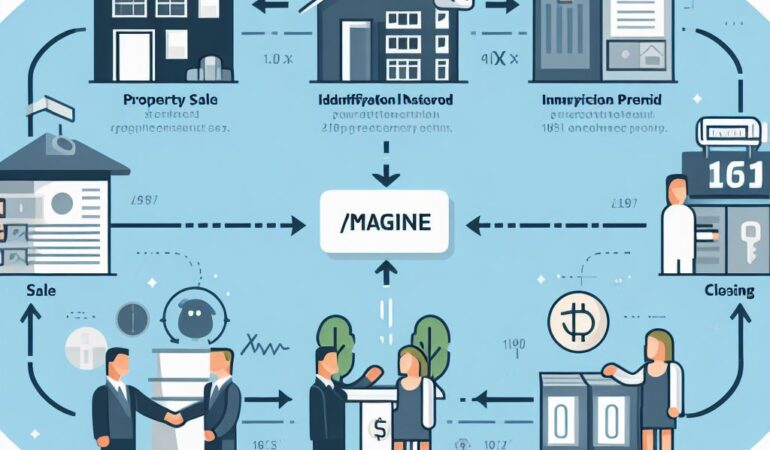Are you tired of being in the dark about the 1031 exchange process? Look no further.
This article will shed light on the intricacies of this tax-deferral strategy. Discover how to identify qualifying properties, meet critical timelines, and complete the exchange transaction successfully.
Gain a clear understanding of the tax implications and benefits involved.
Don’t let confusion hold you back – demystify the 1031 exchange process and take control of your investments today.
Key Takeaways
- A 1031 exchange allows for tax deferral on the sale of investment property.
- Strict timelines must be followed, with 45 days to identify replacement properties and 180 days to close on them.
- Properly identifying replacement properties is crucial to avoid disqualification.
- Strategic use of 1031 exchanges can indefinitely defer tax liability and increase investment returns.
Understanding the 1031 Exchange Basics
To understand the 1031 exchange process, you need to grasp the fundamental principles of this tax-deferral strategy. A 1031 exchange, also known as a like-kind exchange, allows you to defer capital gains taxes on the sale of investment property by reinvesting the proceeds into another property of equal or greater value. The key concept here is that the properties involved must be of like-kind, meaning they’re similar in nature or use. This opens up opportunities for real estate investors to leverage their gains and continually grow their investment portfolios.
One important requirement of a 1031 exchange is the strict timeline that must be followed. From the date of the sale of the relinquished property, you have 45 days to identify potential replacement properties. This identification must be done in writing and submitted to a qualified intermediary or the person facilitating the exchange. Once the identification is made, you have 180 days to close on the replacement property. It’s crucial to adhere to these timelines to successfully complete the exchange and defer your capital gains taxes.
Another crucial aspect of a 1031 exchange is the role of the qualified intermediary. This is a neutral third party who holds the proceeds from the sale of the relinquished property and facilitates the exchange. Their involvement ensures that you, as the taxpayer, don’t have actual or constructive receipt of the funds, which is required by the IRS to qualify for tax deferral. The qualified intermediary also helps to ensure that all the necessary documentation and paperwork is properly completed, minimizing the risk of disqualification.
Identifying Qualifying Properties for Exchange
Now, let’s delve into the process of identifying qualifying properties for your 1031 exchange.
To successfully complete a 1031 exchange, you must identify replacement properties within 45 days of selling your relinquished property. The IRS has set forth three identification rules that must be followed:
- Three Property Rule: You may identify up to three replacement properties, regardless of their fair market value. You can acquire any or all of these properties to complete the exchange.
- 200% Rule: You may identify any number of properties as long as the combined fair market value of all identified properties doesn’t exceed 200% of the fair market value of the relinquished property. This rule allows for greater flexibility in identifying suitable replacement properties.
- 95% Rule: You may identify any number of properties, regardless of their fair market value, as long as you acquire at least 95% of the identified properties by the end of the exchange period. This rule provides the most flexibility but requires a higher level of diligence to ensure successful completion of the exchange.
It is crucial to carefully consider your investment goals, financial capabilities, and the market conditions before identifying replacement properties.
Now that you understand the process of identifying qualifying properties, let’s move on to the next step: meeting the timelines and deadlines to ensure a smooth 1031 exchange process.
Meeting the Timelines and Deadlines
Ensure that you meet the necessary timelines and deadlines to successfully navigate the 1031 exchange process and complete your property acquisition. The 1031 exchange process involves strict deadlines that must be adhered to in order to qualify for tax deferment.
Once you sell your relinquished property, you have 45 days to identify potential replacement properties. This identification must be done in writing and provided to a qualified intermediary, who’ll hold the funds from the sale of your relinquished property. It’s crucial to accurately identify the replacement properties within this timeframe to avoid disqualification from the exchange.
After identifying the replacement properties, you have a total of 180 days from the sale of your relinquished property to complete the exchange transaction. This period includes the initial 45-day identification period. It’s important to note that these timelines are strict and can’t be extended, so it’s essential to stay organized and diligent throughout the process.
Meeting these timelines and deadlines is crucial to successfully completing a 1031 exchange. Failing to do so could result in the loss of tax deferment benefits. Once you have met the necessary timelines and deadlines, you can move on to the next step of completing the exchange transaction.
Completing the Exchange Transaction
Once you have successfully met the necessary timelines and deadlines, completing the exchange transaction is the final step in the 1031 exchange process. This is the moment where you can finally reap the benefits of your efforts.
The completion of the exchange transaction involves the following steps:
- Closing on the Replacement Property: After identifying the replacement property within the specified timeframe, you must initiate the closing process. This includes reviewing and signing the necessary documents, such as the purchase agreement, title commitment, and loan documents. It’s crucial to ensure that all legal and financial aspects are properly addressed to avoid any complications.
- Funding the Exchange: To complete the exchange, you must transfer the proceeds from the sale of your relinquished property to a qualified intermediary. The intermediary will hold the funds until they’re used to acquire the replacement property. It’s important to work closely with your intermediary to ensure a smooth and compliant transfer of funds.
- Recording the Deed: Once the closing is complete, the final step is to record the deed for the replacement property. This establishes your legal ownership of the property and finalizes the exchange transaction. Recording the deed ensures that the transfer is properly documented and protects your rights as the new property owner.
Navigating the Tax Implications and Benefits
To navigate the tax implications and benefits of a 1031 exchange, you need to understand how it can impact your financial situation. When you sell a property and reinvest the proceeds into another like-kind property, you can defer the capital gains tax that would normally be due. This tax deferral allows you to keep more of your money working for you in the new investment.
By deferring the taxes, you have the potential to grow your wealth faster through the power of compounding. It’s important to note that the tax deferral isn’t a permanent tax savings, but rather a temporary postponement of the tax liability. However, by strategically using 1031 exchanges, you can continue to defer your tax liability indefinitely, effectively increasing your investment returns.
Additionally, a 1031 exchange can provide you with the opportunity to diversify your real estate portfolio and potentially increase your cash flow. By acquiring properties that have the potential for higher rental income or greater appreciation, you can enhance your overall financial position. However, it’s crucial to consult with a tax professional or financial advisor to fully understand the tax implications and benefits specific to your situation.
Frequently Asked Questions
Are There Any Restrictions on the Types of Properties That Can Be Exchanged Under a 1031 Exchange?
There are restrictions on the types of properties that can be exchanged under a 1031 exchange. These include requirements for like-kind properties and limitations on personal use properties.
Can a 1031 Exchange Be Used for International Properties?
Yes, you can use a 1031 exchange for international properties. However, there are additional rules and regulations that you need to be aware of when it comes to exchanging properties outside of the United States.
What Happens if the Replacement Property Identified Cannot Be Acquired Within the Specified Timeline?
If you cannot acquire the replacement property within the specified timeline, you will not be able to complete the 1031 exchange. Any gain from the sale of the relinquished property will be taxed.
Is It Possible to Complete a Partial Exchange, Rather Than Exchanging the Entire Property?
Yes, it is possible to complete a partial exchange. You can exchange a portion of your property for a like-kind property, as long as it meets the requirements of a 1031 exchange.
What Are the Potential Tax Consequences if the Exchange Is Not Successfully Completed Within the Required Timelines?
If the exchange is not successfully completed within the required timelines, you may face potential tax consequences. It is crucial to adhere to the timelines to avoid these consequences and ensure a successful exchange.




